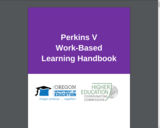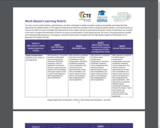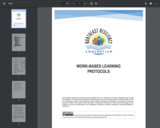
Tools and Ideas for educators who want to provide more authentic learning opportunities to kids.
- Subject:
- Business and Communication
- Career and Technical Education
- Material Type:
- Reading
- Author:
- Stephanie Lane
- Laura Williams
- Date Added:
- 09/11/2019

Tools and Ideas for educators who want to provide more authentic learning opportunities to kids.

Internships are an important mechanism for providing students an opportunity to explore a career and apply the skills and knowledge from school into a business setting. Canby High School was awarded a CTE Revitalization grant in 2011 to help them expand their internship program. Below are the resources and forms that Canby developed to guide the implementation of this project.

The Oregon Career Connected Learning Framework graphic provides a visual representation of Oregon's definition of CCL and potential activities that learners can participate in during their career education and development. Under the umbrella of Career Connected Learning, there are 4 domains: Awareness, Exploration, Preparation and Training. Within the 2 domains of Preparation and Training, lies the opportunity for Work-based learning.Users may incorporate this graphic into their work when communicating and providing professional development with regards to the CCL Framework and its four domains.

What is the purpose of this handbook?
The purpose of this handbook is to provide a shared resource for schools, districts, business,
industry, and community partners in support of a statewide effort to build a robust work-based
learning ecosystem in Oregon. The ultimate goals of supporting implementation of high quality
work-based learning are to ensure equitable learning outcomes for students, to connect
classroom learning with the world of work, and to strengthen community and school
partnerships.

The rubric can be used by teachers, administrators, and other individuals to design and deliver quality and equitable work-based learning experiences for students within a CTE Program of Study that will meet the secondary Perkins V program quality indicator. It can also be used as a resource to reflect on areas of strength and improvements and to adopt continuous improvement processes. Equity considerations are included
in the rubric to support the elimination of barriers to access and participation in work-based learning. The rubric is focused primarily on quality work-based learning experiences, not programs, and performance levels are aligned with the High Quality Program of Study Rubric for an approved CTE Program of Study.

WBL Protocols is a standard set of tools and processes that are responsive to student and employer needs and reinforces the idea that developing such experiences is both very important and requires real work by professionals who approach their work in a well organized way. This document’s primary aim is to share NRC’s experiences with practitioners in colleges and workforce development organizations who are interested in developing quality WBL programs for their students. It defines not only the roles and responsibilities of all parties involved in the process, but also the elements of quality program planning, implementation, and evaluation. It also illustrates how WBL is executed in the NRC colleges and provides useful tools and templates.

This website is a digital handbook written for people at Twinfield Union School who, at one time or another, place students in work-based learning experiences. The website provides information and resources with the intention to lead to consistency when placing students in work-based learning experiences and assessing their learning.
NOTE: Almost all of the information and resources in this handbook are verbatim from either from the Work-based Learning Coordinator graduate class, the Vermont Work-based Learning Manual or government documents.